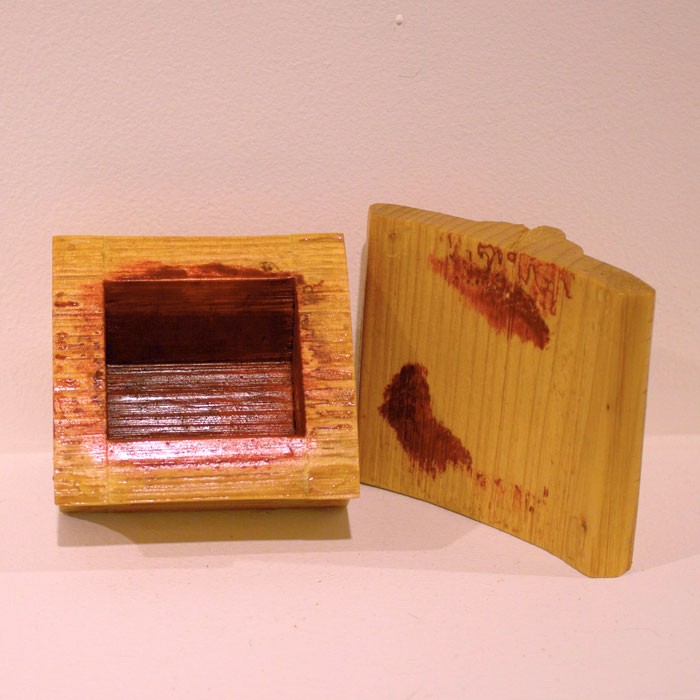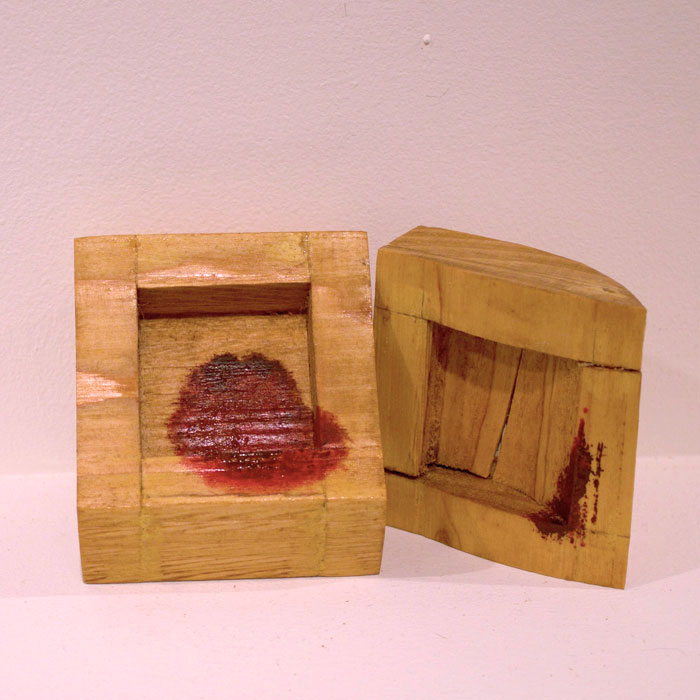If you create or own art
concerning menstruation or menopause and are
interested in showing it on thesepages (it's
free!), contact MUM
Marie Claire magazine
(Italian edition) featured several of the
above artists in an article
about this museum and menstruation in 2003.
The newspaper Corriere della Sera (Io Donna
magazine) (Milan, Italy) and the magazine
Dishy (Turkey) showed some of the artists in
2005 in articles about this museum.


|

The Art of Menstruation at the
Museum of Menstruation and Women's Health
The art of Katy Luxion, page 2 (page 1)
Read about the artist and her work at the
bottom of this page.
 |
 |
 |
|

All photos, art and text
copyright 2011 Katy Luxion
|
|
Biography:
Katy Luxion was born and
raised in the western
suburbs of Chicago,
Illinois. From childhood,
it was obvious that she
has a passion for the
arts, and has spent the
better part of her life
pursuing that goal, both
in and outside of
academia.
Katy holds an
Associate's in Fashion
Design from College of
DuPage, a Bachelor's in
Interactive Media Studies
with a focus in Graphic
Design at North Central
College, and recently
completed her Masters of
Fine Arts in Studio Art
with an emphasis in Design
and Sculpture at Memphis
College of Art.
Her work has been
featured all throughout
the United States,
including Chicago and
Memphis, and was recently
displayed at the Kinsey
Institute in Indiana.
Introduction:
"An unopened box is
only a vessel, a
package, a container.
Yet, because the
contents are unknown, a
box has a powerful air
of mystery. It lures
with the promise that
something desirable lies
concealed inside."
Tony Lydgate*
A box is an object that
we associate with
function, with little to
no additional thought. It
stores our belongings,
hiding them away from
sight until we have a need
for them. But what happens
when we're told this
function, or purpose, has
been removed? Or when the
general opinion of society
suggests that we should be
uncomfortable or secretive
about owning or using
these objects?
When euphemisms (i.e.,
box) are connected back to
the human body, they serve
as stand-ins for female
genitalia. Within this
body of work the box
stands in for my uterus in
two ways. The first is to
look at how menstruation
has a history of being
concealed and why these
taboos have remained in
place. As all of the boxes
have lids, simulated blood
stains reside within the
boxes. I've found that
female sexuality, or the
other way in which my
uterus is viewed, tends to
also remain concealed. The
boxes are able to open and
close, allowing for the
menstrual blood to flow,
while implying that upon
reaching menarche a woman
becomes sexually viable.
Once there is a presence
of sexual activity, the
boxes become stained,
being further set apart
from the rest by having
broken or dysfunctional
lids.
The installation of the
work plays an important
role in how the work is
seen as well.
As you enter the
gallery, a table with
gloves and legends serve
as an invitation to the
viewer, offering
interaction with the work.
The height of the table
will be level with the
shelves that will follow
it along the wall, the top
resting at 35". With the
shelves at this height,
the boxes correlate
directly to the height of
my uterus. Sitting next to
the couch is a shorter
version of the tables,
supporting a legend along
with a pair of gloves and
the box symbolizing the
only cycle I've missed.
Each box represents an
event, a menstrual cycle
that has taken place
within my life. My own
journey with sexuality and
womanhood has been shaped
by those menstrual
experiences. A fainting
couch, upholstered in lace
and silk chiffon,
accompanies the boxes.
Placed near the arm of the
couch is a simulated
menstrual stain. The size
of the stain is as if I
was caught by surprise, or
experienced leaking during
a cycle while I was seated
on the couch. The legs of
the chair are mimic human
legs. Paired with a front
medallion (vagina) and
back medallion (anus) that
mimic the body, the couch
becomes a stand-in for
myself.
The times where staining
is seen on the outside of
the box is due to leaking
or accidental staining,
which is common during
menstruation.
The menstrual taboos
help to shield female
sexuality as a means of
curbing disease and
control the population of
early cultures, so as not
to run out of resources.
The latex gloves mimic
the use of latex condoms,
as well as the gloves that
are worn during medical
exams.
* Lydgate,
Tony. The Art of
Making Elegant Wood
Boxes. New York:
Sterling Pub., 1993.
Print.
|
|
Next artist:
Sarah
McCutcheon
See all the
artists in the links in the
left-hand column.
If you create or own art
concerning menstruation or
menopause and are interested in
showing it on these pages (it's
free!), contact MUM
© 20011 Harry Finley. It
is illegal to reproduce or
distribute work on this Web site in
any manner or medium without written
permission of the author. Please
report suspected violations to hfinley@mum.org
|
|






